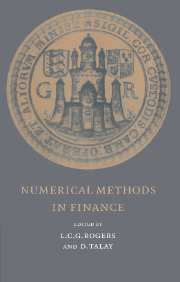Book contents
- Frontmatter
- Contents
- Contributors
- Introduction
- Convergence of Numerical Schemes for Degenerate Parabolic Equations Arising in Finance Theory
- Continuous-Time Monte Carlo Methods and Variance Reduction
- Recent Advances in Numerical Methods for Pricing Derivative Securities
- American Options: A Comparison of Numerical Methods
- Fast, Accurate and Inelegant Valuation of American Options
- Valuation of American Option in a Jump-diffusion Models
- Some Nonlinear Methods for Studying Far-from-the-money Contingent Claims
- Monte Carlo Methods for Stochastic Volatility Models
- Dynamic Optimization for a Mixed Portfolio with Transaction Costs
- Imperfect Markets and Backward Stochastic Differential Equations
- Reflected Backward SDEs and American Options
- Numerical Methods for Backward Stochastic Differential Equations
- Viscosity Solutions and Numerical Schemes for Investment/Consumption Models with Transaction Costs
- Does Volatility Jump or Just Diffuse? A Statistical Approach
- Martingale-Based Hedge Error Control
- The Use of Second-Order Stochastic Dominance To Bound European Call Prices: Theory and Results
Convergence of Numerical Schemes for Degenerate Parabolic Equations Arising in Finance Theory
Published online by Cambridge University Press: 05 June 2012
- Frontmatter
- Contents
- Contributors
- Introduction
- Convergence of Numerical Schemes for Degenerate Parabolic Equations Arising in Finance Theory
- Continuous-Time Monte Carlo Methods and Variance Reduction
- Recent Advances in Numerical Methods for Pricing Derivative Securities
- American Options: A Comparison of Numerical Methods
- Fast, Accurate and Inelegant Valuation of American Options
- Valuation of American Option in a Jump-diffusion Models
- Some Nonlinear Methods for Studying Far-from-the-money Contingent Claims
- Monte Carlo Methods for Stochastic Volatility Models
- Dynamic Optimization for a Mixed Portfolio with Transaction Costs
- Imperfect Markets and Backward Stochastic Differential Equations
- Reflected Backward SDEs and American Options
- Numerical Methods for Backward Stochastic Differential Equations
- Viscosity Solutions and Numerical Schemes for Investment/Consumption Models with Transaction Costs
- Does Volatility Jump or Just Diffuse? A Statistical Approach
- Martingale-Based Hedge Error Control
- The Use of Second-Order Stochastic Dominance To Bound European Call Prices: Theory and Results
Summary
Introduction
The aim of this article is twofold: on one hand, we describe a general convergence result which applies to a wide range of numerical schemes (‘monotone schemes’) for nonlinear possibly degenerate elliptic (or parabolic) equation; this type of equation arises naturally in Finance Theory as we will show first. This convergence result was obtained in an article written in collaboration with P.E. Souganidis (1991).
On the other hand, we present several simple numerical schemes for computing the price of different types of ‘simple’ options: American options, lookback options and Asian options. These schemes are all based on ‘splitting methods’ and we want to emphasize the fact that this allows also easy extensions for computing the price of more complex options with complicated contracts (cap, floor, … etc). These schemes also provide examples for which the convergence result of the first part applies. This second part reports on several works in collaboration with J. Burdeau, Ch. Daher & M. Romano (cf. references) which were done in connection with the Research and Development Department of the Caisse Autonome de Refmancement (CDC group).
The article is organized as follows: since the convergence result for numerical schemes relies strongly on the notion of ‘viscosity solutions’, which is a notion of weak solutions for nonlinear elliptic and parabolic equations, we are first going to present this notion of solutions. In order to introduce it, as a motivation, we examine in the first section several examples of equations arising in Finance Theory, and more particularly in options pricing, and we describe the theoretical difficulties in studying them.
- Type
- Chapter
- Information
- Numerical Methods in Finance , pp. 1 - 21Publisher: Cambridge University PressPrint publication year: 1997
- 38
- Cited by



